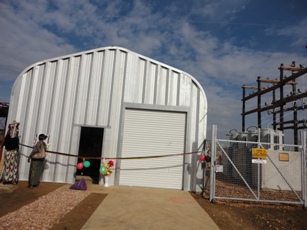S. Sudan, Uganda sign power cooperation deal
October 4, 2017 (JUBA) – Uganda has reached an understanding with neighbouring South Sudan in a deal that will see Kampala extend electricity to South Sudan’s border towns of Kaya and Nimule.

“Uganda is already implementing cross-border electrification with Rwanda and Tanzania which is supplying power to Rakai and we are going to connect power to Eastern DR. Congo,” said Simon D’janga.
“All the power is coming from Uganda. We will supply 400KV of electricity we already have electricity in Nimule and Kaya but on Uganda side and now we want to extend it inside South Sudan,” he added.
South Sudan’s electricity and dams minister, Dhieu Mathok Wol, said the electricity agreement fulfils the regional leaders’ agreement to electrify the border towns so as to spur socio-economic activities in the border towns so as to reduce refugee migrations into Uganda.
“It is President [Yoweri] Museveni’s idea that people in border towns be given electricity to spur socio-economic activities so that it can reduce refugee migrations into Uganda,” Wol told reporters.
Both governments, he said, signed a memorandum of understanding to establish mechanisms for the project’s implementation through allowing the formation of joint committees that will be responsible for mobilizing funds meant for the project.
South Sudan, according to the electricity minister, has the lowest electricity consumption per capita in Sub-Saharan Africa compared to Uganda’s current electricity consumption of about 900MW.
However, as of March 2017, Uganda was reportedly exporting 51.1 megawatts (MW) of electricity to Kenya, 14.94MW to Tanzania and 0.27MW to the Democratic Republic of Congo. Also, besides Karuma (600MW) and Isimba (183MW), the landlocked East African country reportedly boasts of many other mini-hydropower plants, which are expected to add between 100MW and 200MW to the national grid.
South Sudan, statistics from African Development Bank (AfDB) show, has the lowest per capita electricity consumption in Africa, with a per capita consumption of between 1 to 3 kWh, compared to an average in Sub-Saharan Africa of 80 kWh. This is reportedly due partly to the underdeveloped energy infrastructure in the young nation, which has been severely impacted by decades of conflict.
According to a 2013 data, only 1% of South Sudan reportedly has access to grid electricity, due to the low level of power generation and the insufficient distribution network. Also, only 4% of urban areas are reportedly connected to power, but these areas are subject to load shedding and forced power outages.
(ST)
